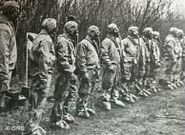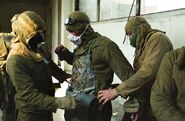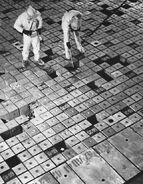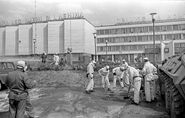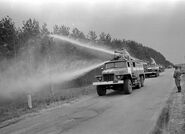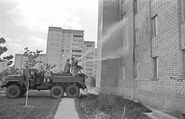|
The cans in the market suddenly stopped having labels. I don't think it was because they ran out of paper.
This page's sources are incomplete, nonexistent or unreliable. You can help the Chernobyl Wiki improve by expanding it.
|
[RU: Ликвидаторы / Военные усилия], [DE: Liquidators / militärischen Anstrengungen]
The liquidators were many groups of people recruited by the army to recduce the effects of the Chernobyl accident. Most died directly or indirectly less than 10 years after the accident.

Soldiers getting ready to climb onto the roof of reactor #3 and remove radioactive debris.
Military Efforts[]
Initially it was the Soviet Army that was called in to help with the accident. Hundreds of soldiers were deployed at the power plant shortly following the explosion, told to bury the reactor. Many were strapped into leaded gear and face masks, sent up onto the roofs of the 3rd and 4th reactors, and told to dump the ejected waste back into the still-burning core. Originally the idea had been to send robots up to do this work, but the intense levels of radiation destroyed the circuits of the machines. The army had no choice but to send in people to do this lethal work. Today, more than 90% of those soldiers who worked on the roofs have died of medical complications caused by their exposure to radiation. As well as climbing onto the roof and man-handling the deadly waste, soldiers who flew helicopters were ordered to fly over the reactor, directly in the path of escaping radionuclides, and drop sand, dolomite and lead onto the inferno to bury it. Most of these pilots died within days following.
Liquidators[]
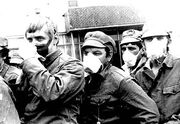
650.000 young men were drafted over a 2-year period after the accident. These men came to be known as "liquidators" and "bio-robots." Not one of them was given sufficient protection from the radiation. The best-protected ones wore thin, clear-plastic suits over their army fatigues and had minimal-protection respirators. The worst protected recieved nothing, and went home to their families in the same contaminated clothing that they'd worked in.

Liquidators in protective clothing and gas masks decontaminate Humvee leave 30-km from exclusion zone
Cleanup Work[]
Many of these people were sent into villages after the residents were evacuated to clean the houses of fallout. Some had high-pressure hoses, others were forced to scrub with their hands. This was not effective, as the radiation was not just in the dust on the houses, it had seeped into the walls because wood absorbs radioactive particles like a sponge.

A liquidator in a radioactive trash heap.
Waste Removal[]
Another part of their efforts was the razing of trees in the forests and the digging up of topsoil. They used ordinary shovels to do this. Once the topsoil was torn up, a special film was sprayed over the light bottom-soil to keep it from moving. The grass was rolled up like large rugs, packed in celophane and buried with the trees in the ground.
Villages[]
More than 70 villages in contaminated areas suffered the same fate: the buildings were picked up off their foundations with large cranes and buried. If cranes were not available at the time, many were simply demolished and then buried or bulldozed into the pits.






